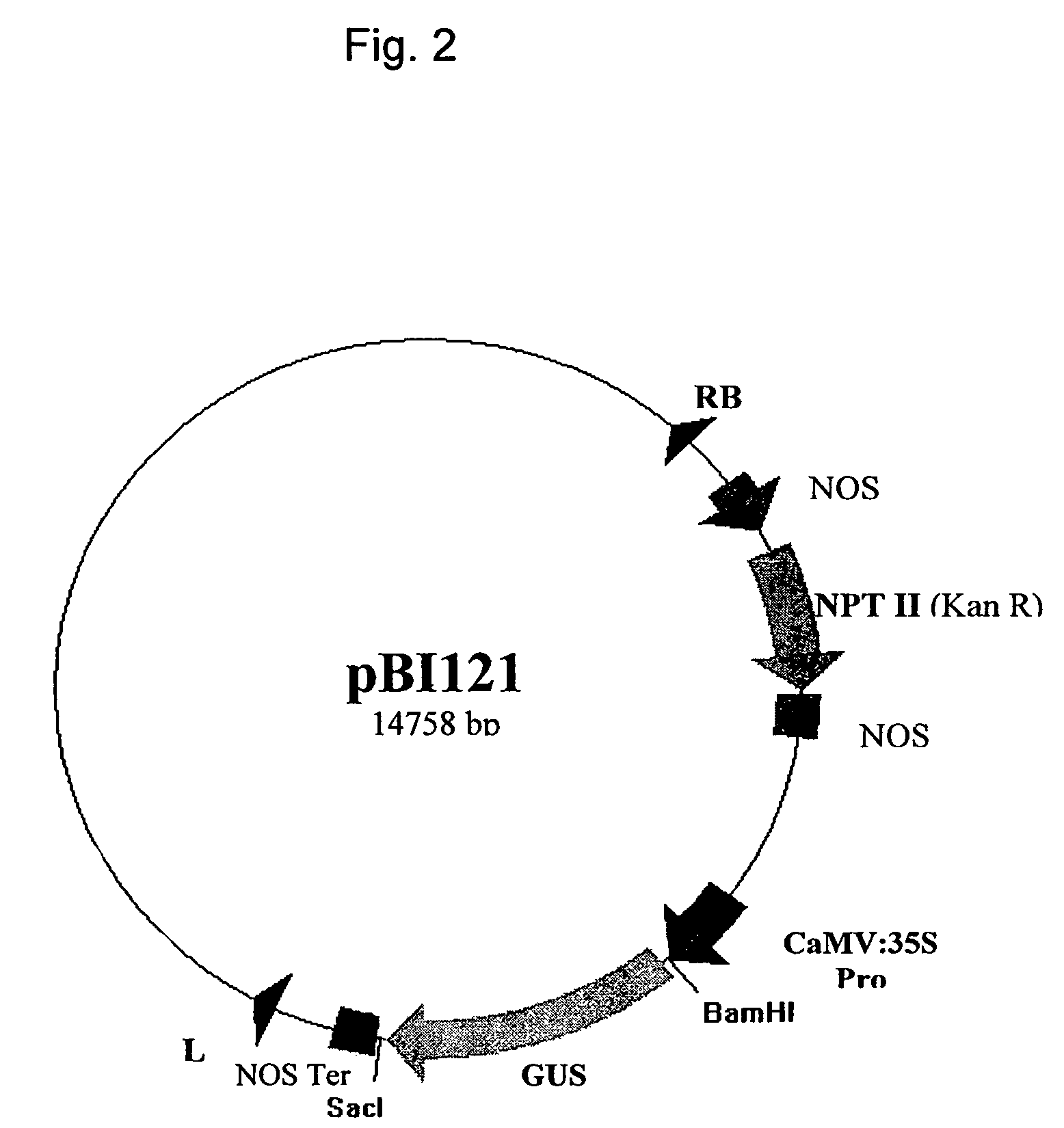Method of enhancing quality factors in cotton
a quality factor and quality technology, applied in the field of molecular biological modification of crops, can solve the problems of reducing the availability of macronutrients, and depleting the mineral nutrients in the soil where cotton is grown, so as to improve the quality of cotton, reduce the nutrient requirements, and increase the fiber yield
- Summary
- Abstract
- Description
- Claims
- Application Information
AI Technical Summary
Benefits of technology
Problems solved by technology
Method used
Image
Examples
example 1
Production of Transgenic Cotton Plants Expressing a Mutant Canola FAD2 Gene
[0077]Plants were produced using the following methods. Cotyledon pieces (approximately 3 mm2) were excised from 7-14 day old cotton (Gossypium hirsutum, L., cv. Coker312) seedlings germinated aseptically according to known methods. See Thomas et al., Plant Cell Reports 14:758-762, 1995; Trolinder and Goodin, Plant Cell Tissue Org. Culture 12:43-53, 1988. Seedlings were grown at 30° under a 14 hour photoperiod, 60 μmol / s / m2.
[0078]Cotton explants were co-cultivated with 6×108 cells / mL Agrobacterium tumefaciens LBA4404, harboring the binary vector pBI121 for vector-only control experiments, or pZPhMCFd2 for fatty acid modification. Transgenic plants were regenerated by somatic embryogenesis. pZPHMCFd2, a binary vector, contains the Ti-plasmid left and right border (LB, RB) inverted repeat sequences for integration into cotton genomic DNA. The T-DNA segment harbors the selectable marker neomycin phosphotransfera...
example 2
Oleic Acid and Total Lipid Content in Seeds From a Primary Transformant Cotton Line
[0084]Seeds from line ZpH 84a primary transformants and several T3 progeny derived from this line were compared with respect to the relationship between oleic acid percentage and total lipid content. See Table I, below. Oleic acid percentage was measured by gas chromatography on lipid extracted from 8-seed pooled samples. Total lipid was measured gravimetrically on extracts from 3- to 4-seed pooled samples (approximately 250 mg mass). Total lipid values are mean±standard deviation, n=3. Values for seeds of the Coker312 background line (and vector-only control, PBI-121) are shown for comparison. These data indicate that a reduction in seed oil was associated with a modification in oleic acid percentage, although values varied somewhat.
[0085]
TABLE IOleic Acid and Total Lipid Content in Transformed Cotton SeedSeed% Oleic acid% Total lipidCoker31214.714.4 ± 1.13PBI-12117.417.6 ± 1.47Zph 84a T1 (primary tr...
example 3
Seed Germination of Transgenic Plants
[0086]T1 seed from the eight independent insertion events discussed in Example 1 were germinated using methods known in the art specifically to maximize percent germination. Briefly, the conditions included germination in moist blotter paper maintained at a constant temperature of 30° C. Because the seeds had been stored for 4 years prior to germination, which exceeds the optimum storage life for cotton planting seed of 2 to 3 years, germination was conducted under optimum temperatures for cotton as defined by the International Seed Testing Association (30° C.) and near-sterile conditions. Those seedlings that successfully germinated were evaluated for hypocotyl and radicle length on day 4 after planting, prior to transplanting into potting soil. None of the seedlings of the lowest oil content insertion event survived.
[0087]When plants reached the 10-leaf stage, PCR was used to determine the presence of the canola FAD2 gene insert in leaf tissue....
PUM
| Property | Measurement | Unit |
|---|---|---|
| pH | aaaaa | aaaaa |
| pH | aaaaa | aaaaa |
| temperature | aaaaa | aaaaa |
Abstract
Description
Claims
Application Information
 Login to View More
Login to View More - R&D
- Intellectual Property
- Life Sciences
- Materials
- Tech Scout
- Unparalleled Data Quality
- Higher Quality Content
- 60% Fewer Hallucinations
Browse by: Latest US Patents, China's latest patents, Technical Efficacy Thesaurus, Application Domain, Technology Topic, Popular Technical Reports.
© 2025 PatSnap. All rights reserved.Legal|Privacy policy|Modern Slavery Act Transparency Statement|Sitemap|About US| Contact US: help@patsnap.com



